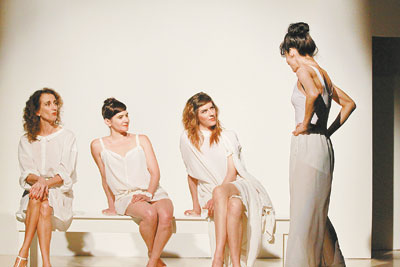
Cao Zhen
caozhen0806@126.com
FRENCH artist Guy de Cointet’s “Five Sisters,” a four-woman performance, was staged at OCT Contemporary Art Terminal (OCAT) last weekend, impressing audiences with its tried-and-true, all-white setting and aesthetic lighting. The 45-minute English-language performance ignores the codes of conventional narrative — plot, suspense, character — in favor of visual and symbolic elements.
The plot is simple and not very crucial. Four sisters meet one Sunday afternoon at their old house in California, the United States. Maria has just returned from Africa and has developed an aversion to the sun. Yvonne is a painter who is eager to hear others’ comments, while Dolly is a busy executive with strong identity problems. Rachel keeps changing her clothes and experiences several mysterious maladies. The four are waiting for the fifth sister Eileen,
The performance explores the well-being of the sisters through their discussions of wardrobe, sun tanning, health, exotic holidays, work and painting. The California sun provokes their reactions, emotions and moods. Everyone busies themselves with the problems and pleasures of modern life. “Five Sisters” is a collage of archetypal reflections about beauty, self-help and feigned emotions.
Mood is critical. Performers are dressed entirely in white, standing in front of a white wall or lying on a white bench. They become screens of different lights and their mood is influenced by lights and colors. De Cointet would often link mood to specific objects or props in his other performances. “Five Sisters” marks a departure from his earlier work in its intention to use light as the main catalyst of emotion.
“Five Sisters” was first performed in 1982 in Los Angeles. De Cointet collaborated with sculptor Eric Orr, who created the stage, lighting, and sound for the original production. The restaging of “Five Sisters” is the result of research conducted by art historian Marie de Brugerolle, as part of “If I Can’t Dance, I Don’t Want to Be Part of Your Revolution,” a performance residency program in The Netherlands. In this new production, the lighting and sound are reconstructed by Eric Orr’s daughter, Elizabeth.
“My father mainly used red, blue and white colors for the stage lighting and I basically followed him for the restaging. But for some parts, I changed the lighting and sometimes I left the actresses standing in the dark,” said Elizabeth Orr after the show Friday night at OCAT.
“The language of the lighting in ‘Five Sisters’ is elaborative and abstract, blended with the movements of the characters. In a sense, the lighting becomes the fifth sister, or I become the fifth sister, because each time I do the lighting at different places my mood changes with the performers,” said Elizabeth Orr.
The Shenzhen performance was curated by Frédérique Bergholtz, co-founder and director of “If I Can’t Dance, I Don’t Want to Be Part of Your Revolution.” “With ‘Five Sisters,’ we aim to research performance art as case studies. We want to offer researchers a context for in-depth study into performances that we consider important from an art historical perspective, as well as from the point of view of contemporary practice in performance,” she said at a seminar Saturday in OCAT.
Bergholtz said they began to study “Five Sisters” in 2010 and have since performed it extensively throughout Europe and the United States. “Superficially, the performance displays women’s gossip on health and beauty, but the work is very funny in its refashioning of clichés. All of the dialogue expresses points about human beings’ anxiety.”
|

